The Effect of Thermal Maturity on the Pore Structure Heterogeneity of Xiamaling Shale by Multifractal Analysis Theory: A Case from Pyrolysis Simulation Experiments
Abstract
:1. Introduction
2. Geological Settings
3. Samples and Methods
3.1. Samples and Experiments
3.2. Hydrous Pyrolysis Experiments
3.3. Multifractal Theory
4. Results
4.1. Mineral Composition and Organic Geochemistry
4.2. NMR Parameters
4.3. Results of the LF-NMR Measurements
4.4. Multifractal Characteristics Based on NMR Experiments
5. Discussion
5.1. Organic Geochemical Variation during Thermal Maturation
5.2. The Variation of Pore Structure Heterogeneity during Thermal Maturation
5.3. The Effect of Thermal Maturity (Ro) on Pore Structure
5.4. Pore Structure and Heterogeneity Evolution Model
6. Conclusions
Author Contributions
Funding
Data Availability Statement
Acknowledgments
Conflicts of Interest
References
- Curtis, M.E.; Cardott, B.J.; Sondergeld, C.H.; Rai, C.S. Development of organic porosity in the Woodford Shale with increasing thermal maturity. Int. J. Coal Geol. 2012, 103, 26–31. [Google Scholar] [CrossRef]
- Loucks, R.G.; Reed, R.M.; Ruppel, S.C.; Hammes, U. Spectrum of pore types and networks in mudrocks and a descriptive classification for matrix-related mudrock pores. AAPG Bull. 2012, 96, 1071–1098. [Google Scholar] [CrossRef]
- Yang, R.; He, S.; Yi, J.; Hu, Q. Nano-scale pore structure and fractal dimension of organic-rich Wufeng-Longmaxi shale from Jiaoshiba area, Sichuan Basin: Investigations using FE-SEM, gas adsorption and helium pycnometry. Mar. Pet. Geol. 2016, 70, 27–45. [Google Scholar] [CrossRef]
- Tang, X.; Jiang, Z.; Jiang, S.; Li, Z. Heterogeneous nanoporosity of the Silurian Longmaxi Formation shale gas reservoir in the Sichuan Basin using the QEMSCAN, FIB-SEM, and nano-CT methods. Mar. Pet. Geol. 2016, 78, 99–109. [Google Scholar] [CrossRef]
- Hou, X.; Zhu, Y.; Chen, S.; Wang, Y.; Liu, Y. Investigation on pore structure and multifractal of tight sandstone reservoirs in coal bearing strata using LF-NMR measurements. J. Pet. Sci. Eng. 2020, 187, 106757. [Google Scholar] [CrossRef]
- Liang, Z.; Jiang, Z.; Li, Z.; Song, Y.; Gao, F.; Liu, X.; Xiang, S. Nanopores Structure and Multifractal Characterization of Bulk Shale and Isolated Kerogen—An Application in Songliao Basin, China. Energy Fuels 2021, 35, 5818–5842. [Google Scholar] [CrossRef]
- Wang, Y.; Cheng, H.; Hu, Q.; Liu, L.; Jia, L.; Gao, S.; Wang, Y. Pore structure heterogeneity of Wufeng-Longmaxi shale, Sichuan Basin, China: Evidence from gas physisorption and multifractal geometries. J. Pet. Sci. Eng. 2022, 208, 109313. [Google Scholar] [CrossRef]
- Chen, K.; Yang, R.; Bao, H.; Dong, T.; Jia, A.; Hu, Q.; Guo, X.; He, S. Depositional-diagenetic process and their implications for pore development of Wufeng-Longmaxi shales in the Jiangdong block, Fuling shale gas field, SW China. Mar. Pet. Geol. 2023, 151, 106177. [Google Scholar] [CrossRef]
- Li, X.; Jiang, Z.; Jiang, S.; Wang, S.; Miao, Y.; Wu, F.; Cao, X. Synergetic effects of matrix components and diagenetic processes on pore properties in the Lower Cambrian shale in Sichuan Basin, South China. J. Nat. Gas Sci. Eng. 2021, 94, 104072. [Google Scholar] [CrossRef]
- Wang, Y.; Liu, L.; Hu, Q.; Hao, L.; Wang, X.; Sheng, Y. Nanoscale Pore Network Evolution of Xiamaling Marine Shale during Organic Matter Maturation by Hydrous Pyrolysis. Energy Fuels 2020, 34, 1548–1563. [Google Scholar] [CrossRef]
- Xu, L.; Yang, K.; Wei, H.; Liu, L.; Jiang, Z.; Li, X.; Chen, L.; Xu, T.; Wang, X. Pore evolution model and diagenetic evolution sequence of the Mesoproterozoic Xiamaling shale in Zhangjiakou, Hebei. J. Pet. Sci. Eng. 2021, 207, 109115. [Google Scholar] [CrossRef]
- Xu, L.; Yang, K.; Wei, H.; Liu, L.; Li, X.; Chen, L.; Xu, T.; Wang, X. Full-Scale Pore Structure Characteristics and the Main Controlling Factors of Mesoproterozoic Xiamaling Shale in Zhangjiakou, Hebei, China. Nanomaterials 2021, 11, 527. [Google Scholar] [CrossRef] [PubMed]
- Liu, H.; Zhang, S.; Song, G.; Xuejun, W.; Teng, J.; Wang, M.; Bao, Y.; Yao, S.; Wang, W.; Zhang, S.; et al. Effect of shale diagenesis on pores and storage capacity in the Paleogene Shahejie Formation, Dongying Depression, Bohai Bay Basin, east China. Mar. Pet. Geol. 2019, 103, 738–752. [Google Scholar] [CrossRef]
- Chen, L.; Jiang, Z.; Jiang, S.; Liu, K.; Yang, W.; Tan, J.; Gao, F. Nanopore Structure and Fractal Characteristics of Lacustrine Shale: Implications for Shale Gas Storage and Production Potential. Nanomaterials 2019, 9, 390. [Google Scholar] [CrossRef] [PubMed]
- Liang, C.; Cao, Y.; Liu, K.; Jiang, Z.; Wu, J.; Hao, F. Diagenetic variation at the lamina scale in lacustrine organic-rich shales: Implications for hydrocarbon migration and accumulation. Geochim. Et Cosmochim. Acta 2018, 229, 112–128. [Google Scholar] [CrossRef]
- Wang, X.P.; Mou, C.L.; Wang, Q.Y.; Ge, X.Y.; Chen, X.W.; Zhou, K.K.; Liang, W. Diagenesis of black shale in longmaxi formation, southern sichuan Basin and its periphery. Acta Pet. Sin. 2015, 36, 1035–1047. [Google Scholar]
- Zhang, S.; Liu, H.M.; Song, G.Q.; Wang, R.S.; Chen, S.Y.; Zhang, S.P. Genesis and control factors of shale oil reserving space in Dongying sag. Acta Pet. Sin. 2016, 37, 1495–1507. [Google Scholar] [CrossRef]
- Guan, M.; Liu, X.; Jin, Z.; Lai, J.; Sun, B.; Zhang, P.; Chen, K. The evolution of pore structure heterogeneity during thermal maturation in lacustrine shale pyrolysis. J. Anal. Appl. Pyrolysis 2022, 163, 105501. [Google Scholar] [CrossRef]
- Gao, Z.; Xuan, Q.; Hu, Q.; Jiang, Z.; Liu, X. Pore structure evolution characteristics of continental shale in China as indicated from thermal simulation experiments. AAPG Bull. 2021, 105, 2159–2180. [Google Scholar] [CrossRef]
- Löhr, S.C.; Baruch, E.T.; Hall, P.A.; Kennedy, M.J. Is organic pore development in gas shales influenced by the primary porosity and structure of thermally immature organic matter? Org. Geochem. 2015, 87, 119–132. [Google Scholar] [CrossRef]
- Wang, X.; Jiang, Z.; Jiang, S.; Chang, J.; Li, X.; Wang, X.; Zhu, L. Pore Evolution and Formation Mechanism of Organic-Rich Shales in the Whole Process of Hydrocarbon Generation: Study of Artificial and Natural Shale Samples. Energy Fuels 2019, 34, 332–347. [Google Scholar] [CrossRef]
- Zhang, Y.; Yu, B.; Pan, Z.; Hou, C.; Zuo, Q.; Sun, M. Effect of thermal maturity on shale pore structure: A combined study using extracted organic matter and bulk shale from Sichuan Basin, China. J. Nat. Gas Sci. Eng. 2020, 74, 103089. [Google Scholar] [CrossRef]
- Milliken, K.L.; Rudnicki, M.; Awwiller, D.N.; Zhang, T. Organic matter-hosted pore system, Marcellus Formation (Devonian), Pennsylvania. AAPG Bull. 2013, 97, 177–200. [Google Scholar] [CrossRef]
- Liu, J.; Zhou, Z.; Liu, X.H.; Ren, S.M.; Liu, Y.M. Geological conditions of the Mesoproterozoic shale gas accumulation in Yanshan area, North China. Acta Petrol. Sin 2019, 40, 268–278. [Google Scholar] [CrossRef]
- Wang, P.; Jiang, Z.; Ji, W.; Zhang, C.; Yuan, Y.; Chen, L.; Yin, L. Heterogeneity of intergranular, intraparticle and organic pores in Longmaxi shale in Sichuan Basin, South China: Evidence from SEM digital images and fractal and multifractal geometries. Mar. Pet. Geol. 2016, 72, 122–138. [Google Scholar] [CrossRef]
- Yang, F.; Ning, Z.; Wang, Q.; Liu, H. Pore structure of Cambrian shales from the Sichuan Basin in China and implications to gas storage. Mar. Pet. Geol. 2016, 70, 14–26. [Google Scholar] [CrossRef]
- Zhang, P.; Yin, Y.; Lu, S.; Li, J.; Chang, X.; Zhang, J.; Pang, Y.; Chen, G.; Liu, Y.; Li, Z. Insights into Pore Structures and Multifractal Characteristics of Shale Oil Reservoirs: A Case Study from Dongying Sag, Bohai Bay Basin, China. Energy Fuels 2022, 36, 8224–8237. [Google Scholar] [CrossRef]
- Zhang, S.; Yan, J.; Hu, Q.; Wang, J.; Tian, T.; Chao, J.; Wang, M. Integrated NMR and FE-SEM methods for pore structure characterization of Shahejie shale from the Dongying Depression, Bohai Bay Basin. Mar. Pet. Geol. 2019, 100, 85–94. [Google Scholar] [CrossRef]
- Ji, W.; Song, Y.; Jiang, Z.; Meng, M.; Liu, Q.; Chen, L.; Wang, P.; Gao, F.; Huang, H. Fractal characteristics of nano-pores in the Lower Silurian Longmaxi shales from the Upper Yangtze Platform, south China. Mar. Pet. Geol. 2016, 78, 88–98. [Google Scholar] [CrossRef]
- Huang, H.; Li, R.; Jiang, Z.; Li, J.; Chen, L. Investigation of variation in shale gas adsorption capacity with burial depth: Insights from the adsorption potential theory. J. Nat. Gas Sci. Eng. 2020, 73, 103043. [Google Scholar] [CrossRef]
- Liu, K.; Ostadhassan, M.; Zou, J.; Gentzis, T.; Rezaee, R.; Bubach, B.; Carvajal-Ortiz, H. Multifractal analysis of gas adsorption isotherms for pore structure characterization of the Bakken Shale. Fuel 2018, 219, 296–311. [Google Scholar] [CrossRef]
- Ji, W.; Song, Y.; Rui, Z.; Meng, M.; Huang, H. Pore characterization of isolated organic matter from high matured gas shale reservoir. Int. J. Coal Geol. 2017, 174, 31–40. [Google Scholar] [CrossRef]
- Li, Z.; Shen, X.; Qi, Z.; Hu, R. Study on the pore structure and fractal characteristics of marine and continental shale based on mercury porosimetry, N2 adsorption and NMR methods. J. Nat. Gas Sci. Eng. 2018, 53, 12–21. [Google Scholar] [CrossRef]
- Zheng, S.; Yao, Y.; Liu, D.; Cai, Y.; Liu, Y.; Li, X. Nuclear magnetic resonance T2 cutoffs of coals: A novel method by multifractal analysis theory. Fuel 2019, 241, 715–724. [Google Scholar] [CrossRef]
- Xu, L.; Yang, K.; Wei, H.; Liu, L.; Li, X.; Chen, L.; Xu, T.; Wang, X. Diagenetic evolution sequence and pore evolution model of Mesoproterozoic Xiamaling organic-rich shale in Zhangjiakou, Hebei, based on pyrolysis simulation experiments. Mar. Pet. Geol. 2021, 132, 715–724. [Google Scholar] [CrossRef]
- Zhao, J.; Jin, Z.; Jin, Z.; Hu, Q.; Hu, Z.; Du, W.; Yan, C.; Geng, Y. Mineral types and organic matters of the Ordovician-Silurian Wufeng and Longmaxi Shale in the Sichuan Basin, China: Implications for pore systems, diagenetic pathways, and reservoir quality in fine-grained sedimentary rocks. Mar. Pet. Geol. 2017, 86, 655–674. [Google Scholar] [CrossRef]
- Chen, J.; Xiao, X. Evolution of nanoporosity in organic-rich shales during thermal maturation. Fuel 2014, 129, 173–181. [Google Scholar] [CrossRef]
- Li, X.; Wang, J.; Li, Z.; Zhang, K.; Feng, X.; Wang, Z. Impact of Brittle Deformation on Pore Structure Evolution in Shale: Samples Collected from Different Fault Positions. Energy Fuels 2022, 36, 1441–1456. [Google Scholar] [CrossRef]
- Hu, G.; Pang, Q.; Jiao, K.; Hu, C.; Liao, Z. Development of organic pores in the Longmaxi Formation overmature shales: Combined effects of thermal maturity and organic matter composition. Mar. Pet. Geol. 2020, 116, 104314. [Google Scholar] [CrossRef]
- Wang, Y.; Qiu, N.; Borjigin, T.; Shen, B.; Xie, X.; Ma, Z.; Lu, C.; Yang, Y.; Yang, L.; Cheng, L.; et al. Integrated assessment of thermal maturity of the Upper Ordovician–Lower Silurian Wufeng–Longmaxi shale in Sichuan Basin, China. Mar. Pet. Geol. 2019, 100, 447–465. [Google Scholar] [CrossRef]
- Hu, H. Porosity evolution of the organic-rich shale with thermal maturity increasing. Acta Pet. Sin. 2013, 34, 820–825. [Google Scholar] [CrossRef]
- Ma, Z.; Zheng, L.; Xu, X.; Bao, F.; Yu, X. Thermal simulation experiment of organic matter-rich shale and implication for organic pore formation and evolution. Pet. Res. 2017, 2, 347–354. [Google Scholar] [CrossRef]
- Fan, W.B. Geological features and research progress of the Mesoproterozoic Xiamaling Formation in the North China Craton: A review after nearly one hundred years of study. Geol. Rev. 2015, 61, 1383–1406. [Google Scholar] [CrossRef]
- Luo, S.S.; Lv, Q.Q.; Shang, F.; Li, L.J. Characteristics of sedimentrary facies of Neoproterozoic Xiamaling formation reservoir in Xuanlong depression. FaultBlock Oil Gas Field 2011, 18, 26–29. [Google Scholar]
- Liu, Z.; Liu, D.; Cai, Y.; Yao, Y.; Pan, Z.; Zhou, Y. Application of nuclear magnetic resonance (NMR) in coalbed methane and shale reservoirs: A review. Int. J. Coal Geol. 2020, 218, 103261. [Google Scholar] [CrossRef]
- Jerry, J.S.; Alan, K.B. Evaluation of a Simple Model of Vitrinite Reflectance Based on Chemical Kinetics (1). AAPG Bull. 1990, 74, 1559–1570. [Google Scholar] [CrossRef]
- Chhabra, A.B.; Meneveau, C.; Jensen, R.V.; Sreenivasan, K.R. Direct determination of the f(alpha) singularity spectrum and its application to fully developed turbulence. Phys. Rev. A Gen. Phys. 1989, 40, 5284–5294. [Google Scholar] [CrossRef]
- Caniego, F.J.; Martí, M.A.; San José, F. Rényi dimensions of soil pore size distribution. Geoderma 2003, 112, 205–216. [Google Scholar] [CrossRef]
- Grassberger, P. Generalized dimensions of strange attractors. Phys. Lett. A 1983, 97, 227–230. [Google Scholar] [CrossRef]
- Wu, S.; Zhu, R.; Cui, J.; Cui, J.; Bai, B.; Zhang, X.; Jin, X.; Zhu, D.; You, J.; Li, X. Characteristics of lacustrine shale porosity evolution, Triassic Chang 7 Member, Ordos Basin, NW China. Pet. Explor. Dev. 2015, 42, 185–195. [Google Scholar] [CrossRef]
- Li, A.; Ding, W.; Wang, R.; He, J.; Wang, X.; Sun, Y.; Gu, Y.; Jiao, N. Petrophysical characterization of shale reservoir based on nuclear magnetic resonance (NMR) experiment: A case study of Lower Cambrian Qiongzhusi Formation in eastern Yunnan Province, South China. J. Nat. Gas Sci. Eng. 2017, 37, 29–38. [Google Scholar] [CrossRef]
- Zhang, Z.; Qin, Y.; Zhuang, X.; Li, G.; Wang, X. Poroperm characteristics of high-rank coals from Southern Qinshui Basin by mercury intrusion, SEM-EDS, nuclear magnetic resonance and relative permeability analysis. J. Nat. Gas Sci. Eng. 2018, 51, 116–128. [Google Scholar] [CrossRef]
- Martínez, G.A.; Davis, L.A. Petrophysical Measurements on Shales Using NMR. In Proceedings of the SPE/AAPG Western Regional Meeting, Long Beach, CA, USA, 19–22 June 2000. [Google Scholar]
- Huang, S.J.; Huang, K.K.; Feng, W.L.; Tong, H.P.; Liu, L.H.; Zhang, X.H. Mass exchanges among feldspar, kaolinite and illite and their influences on secondary porosity formation in clastic diagenesis: A case study on the Upper Paleozoic, Ordos Basin and Xujiahe formation, Western Sichuan depression. Geochimica 2009, 38, 498–506. [Google Scholar]
- Peltonen, C.; Marcussen, Ø.; Bjørlykke, K.; Jahren, J. Clay mineral diagenesis and quartz cementation in mudstones: The effects of smectite to illite reaction on rock properties. Mar. Pet. Geol. 2009, 26, 887–898. [Google Scholar] [CrossRef]
- Fan, M.; He, Z.L.; Li, Z.M.; Yu, L.J.; Zhang, W.T.; Liu, W.X.; Jiang, X.Q. Dissolution window of carbonate rocks and its geological significance. Oil Gas Geol. 2011, 32, 499–500. [Google Scholar]
- Zargari, S.; Canter, K.L.; Prasad, M. Porosity evolution in oil-prone source rocks. Fuel 2015, 153, 110–117. [Google Scholar] [CrossRef]
- Han, Y.; Horsfield, B.; Wirth, R.; Mahlstedt, N.; Bernard, S. Oil retention and porosity evolution in organic-rich shales. AAPG Bull. 2017, 101, 807–827. [Google Scholar] [CrossRef]
- Hou, Y.; Zhang, K.; Wang, F.; He, S.; Dong, T.; Wang, C.; Qin, W.; Xiao, Y.; Tang, B.; Yu, R.; et al. Structural evolution of organic matter and implications for graphitization in over-mature marine shales, south China. Mar. Pet. Geol. 2019, 109, 304–316. [Google Scholar] [CrossRef]
- Xue, Z.; Jiang, Z.; Wang, X.; Gao, Z.; Chang, J.; Nie, Z.; Li, H.; Wu, W.; Qiu, H.; Wang, Q.; et al. Genetic mechanism of low resistivity in high-mature marine shale: Insights from the study on pore structure and organic matter graphitization. Mar. Pet. Geol. 2022, 144, 105825. [Google Scholar] [CrossRef]
- Huang, C.; Ju, Y.; Zhu, H.; Lash, G.G.; Qi, Y.; Yu, K.; Feng, H.; Ju, L.; Qiao, P. Investigation of formation and evolution of organic matter pores in marine shale by helium ion microscope: An example from the Lower Silurian Longmaxi Shale, South China. Mar. Pet. Geol. 2020, 120, 104550. [Google Scholar] [CrossRef]
- Borjigin, T.; Lu, L.; Yu, L.; Zhang, W.; Pan, A.; Shen, B.; Wang, Y.; Yang, Y.; Gao, Z. Formation, preservation and connectivity control of organic pores in shale. Pet. Explor. Dev. 2021, 48, 798–812. [Google Scholar] [CrossRef]
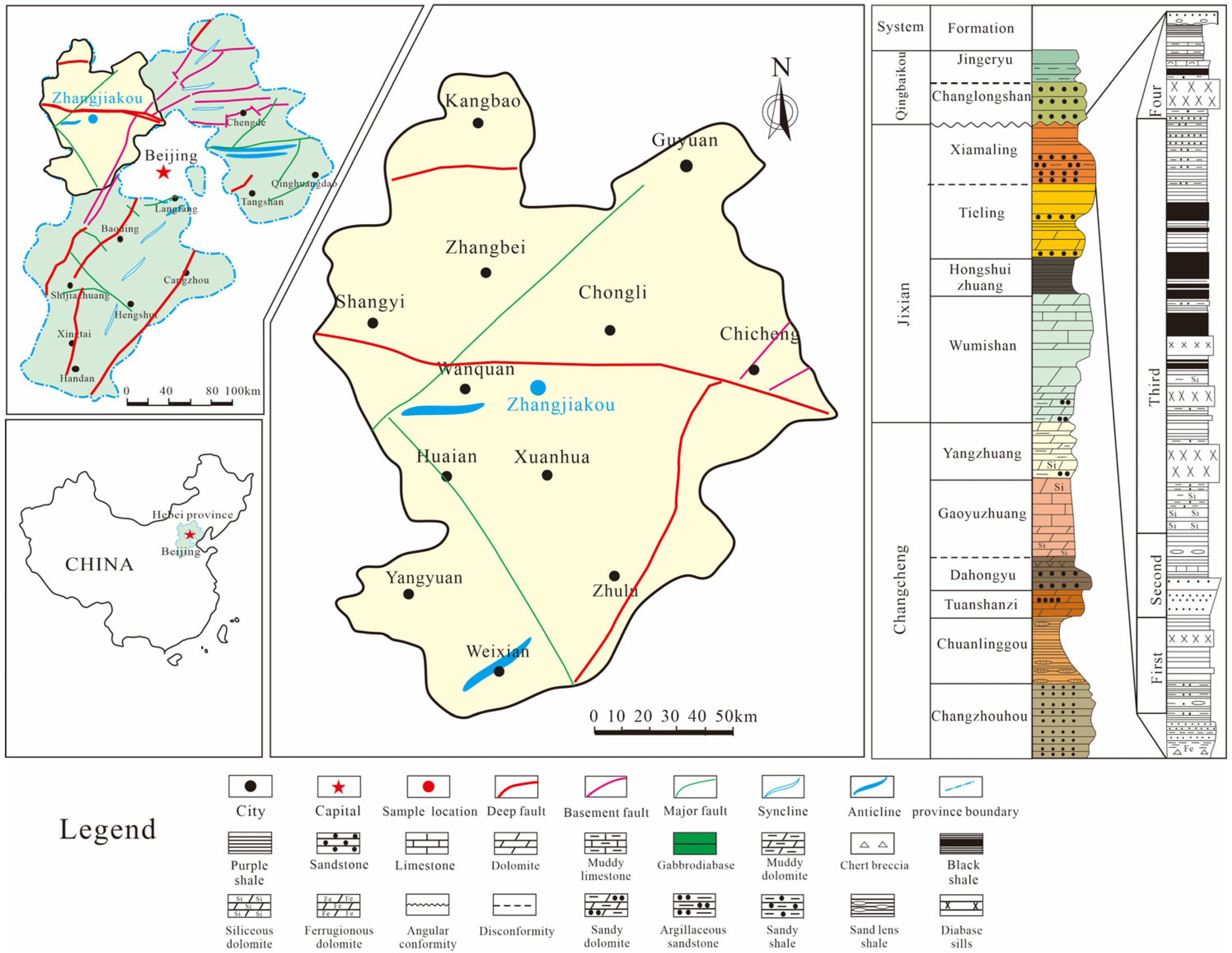

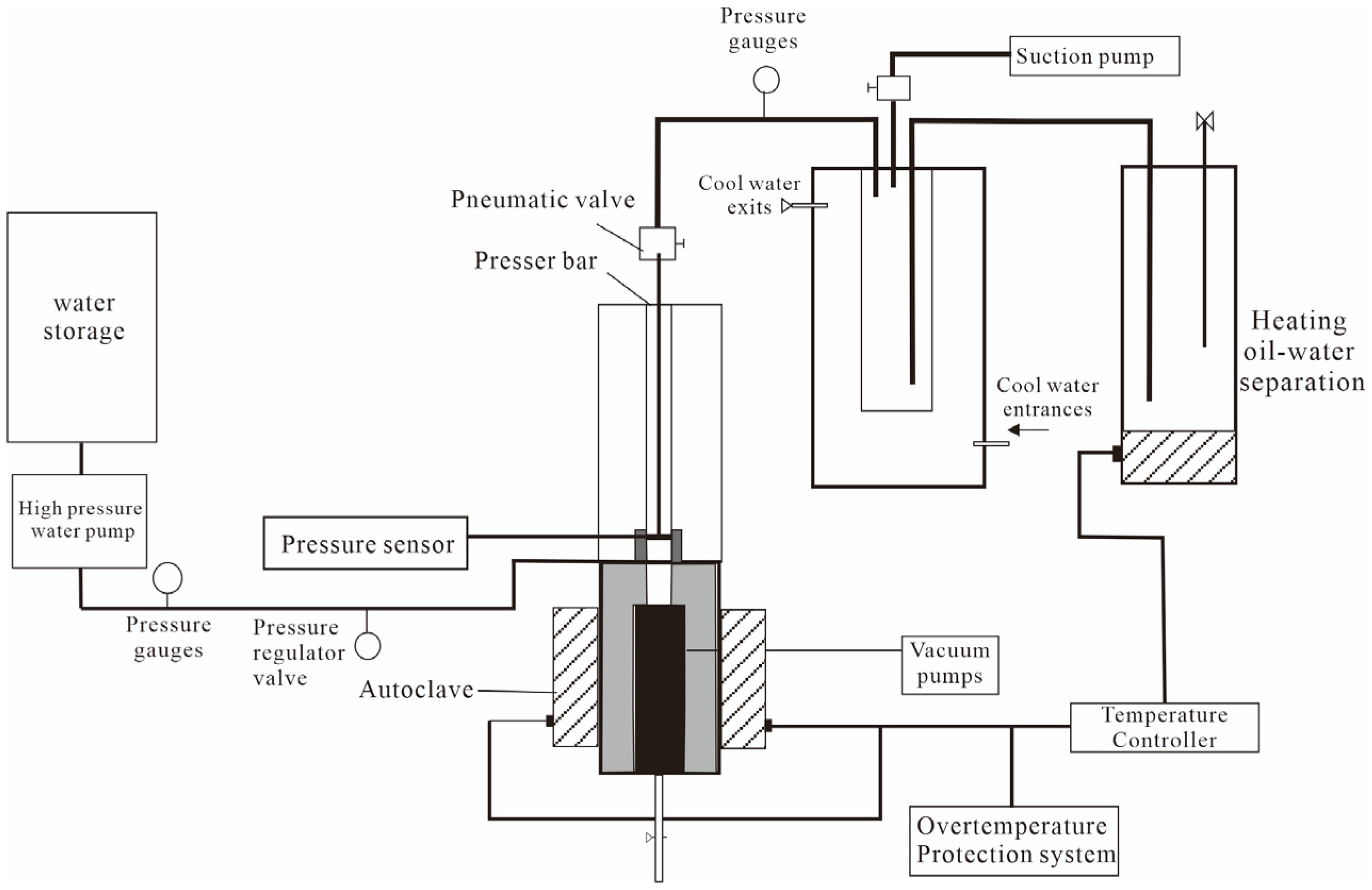
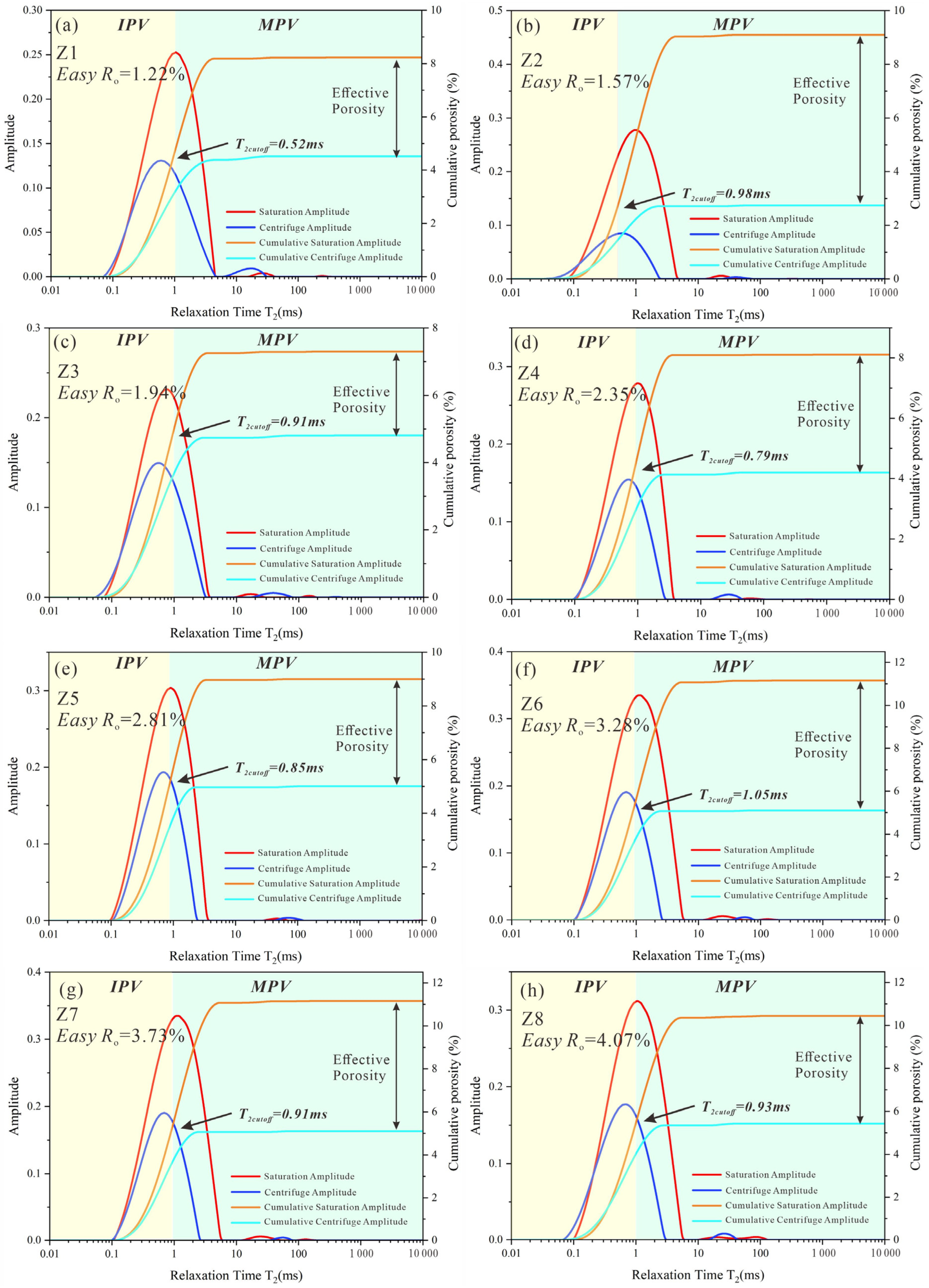
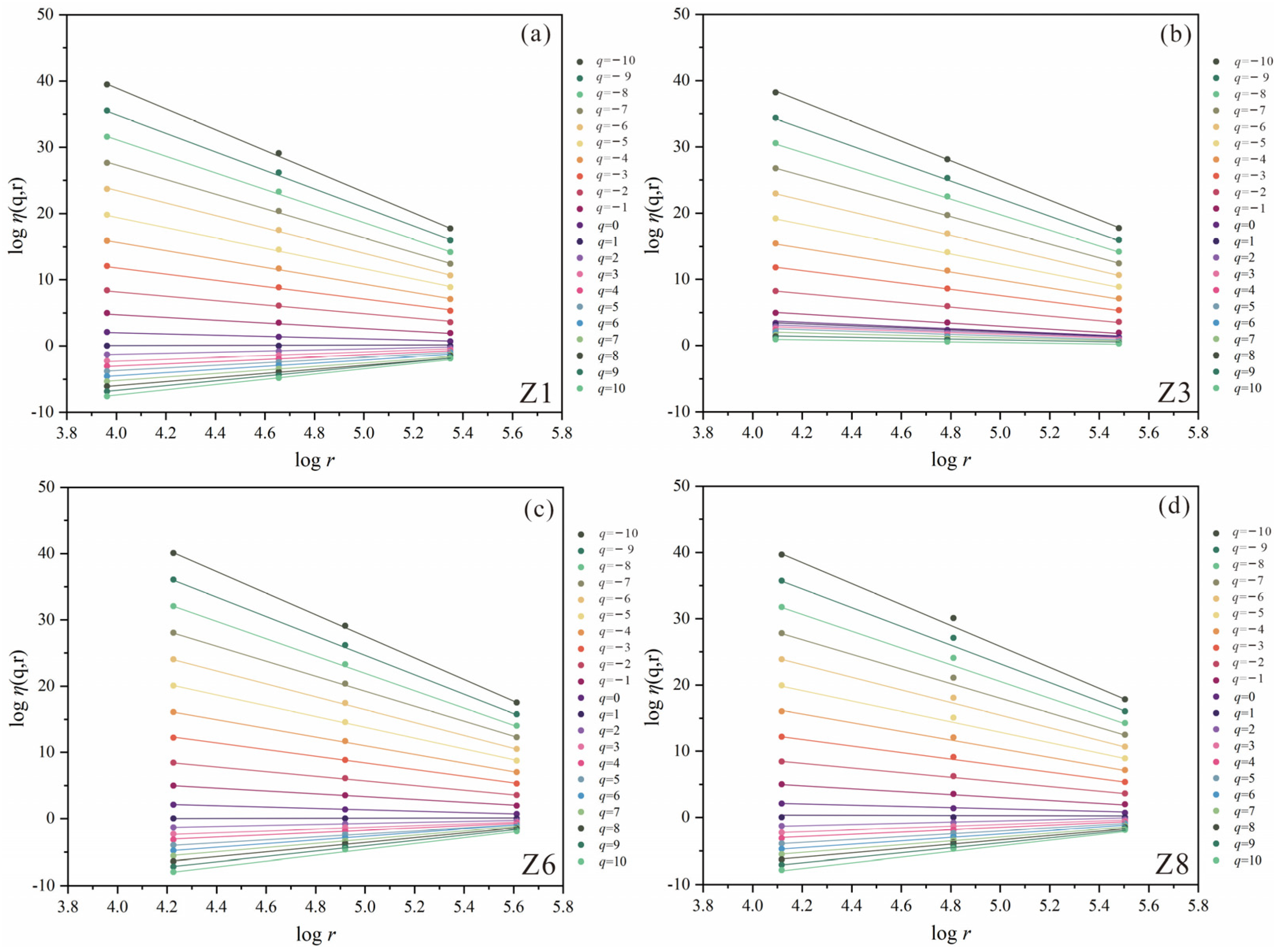

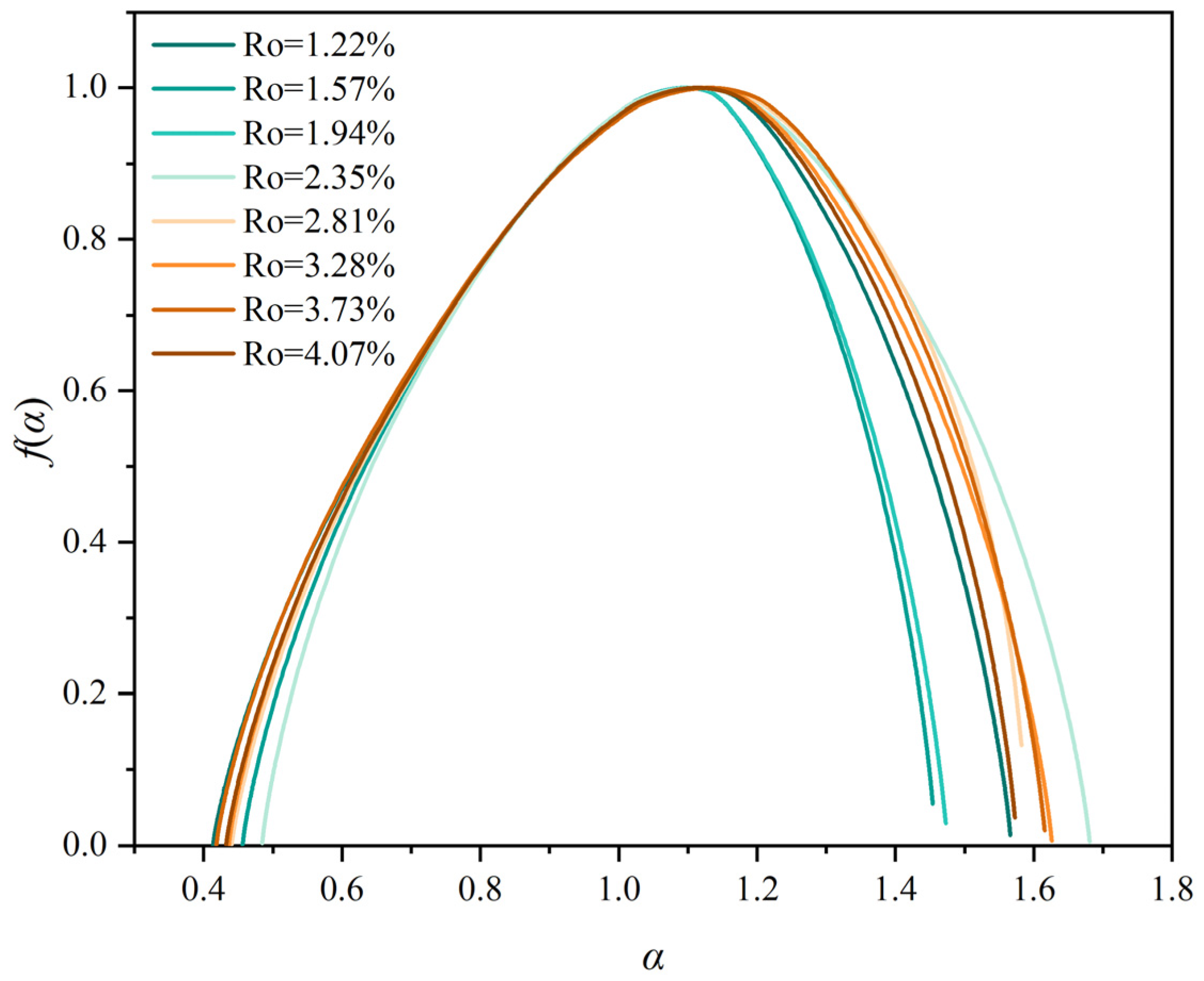
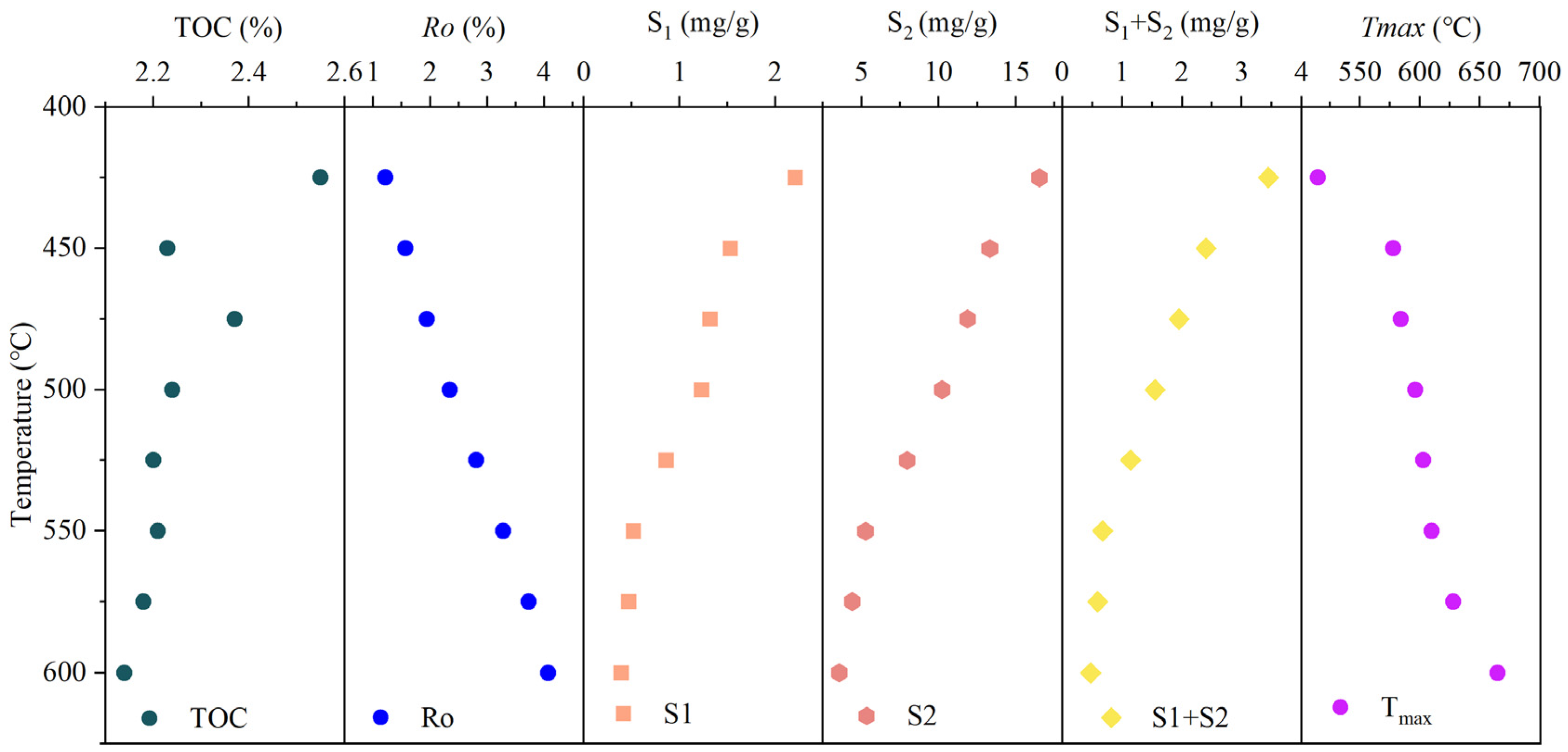

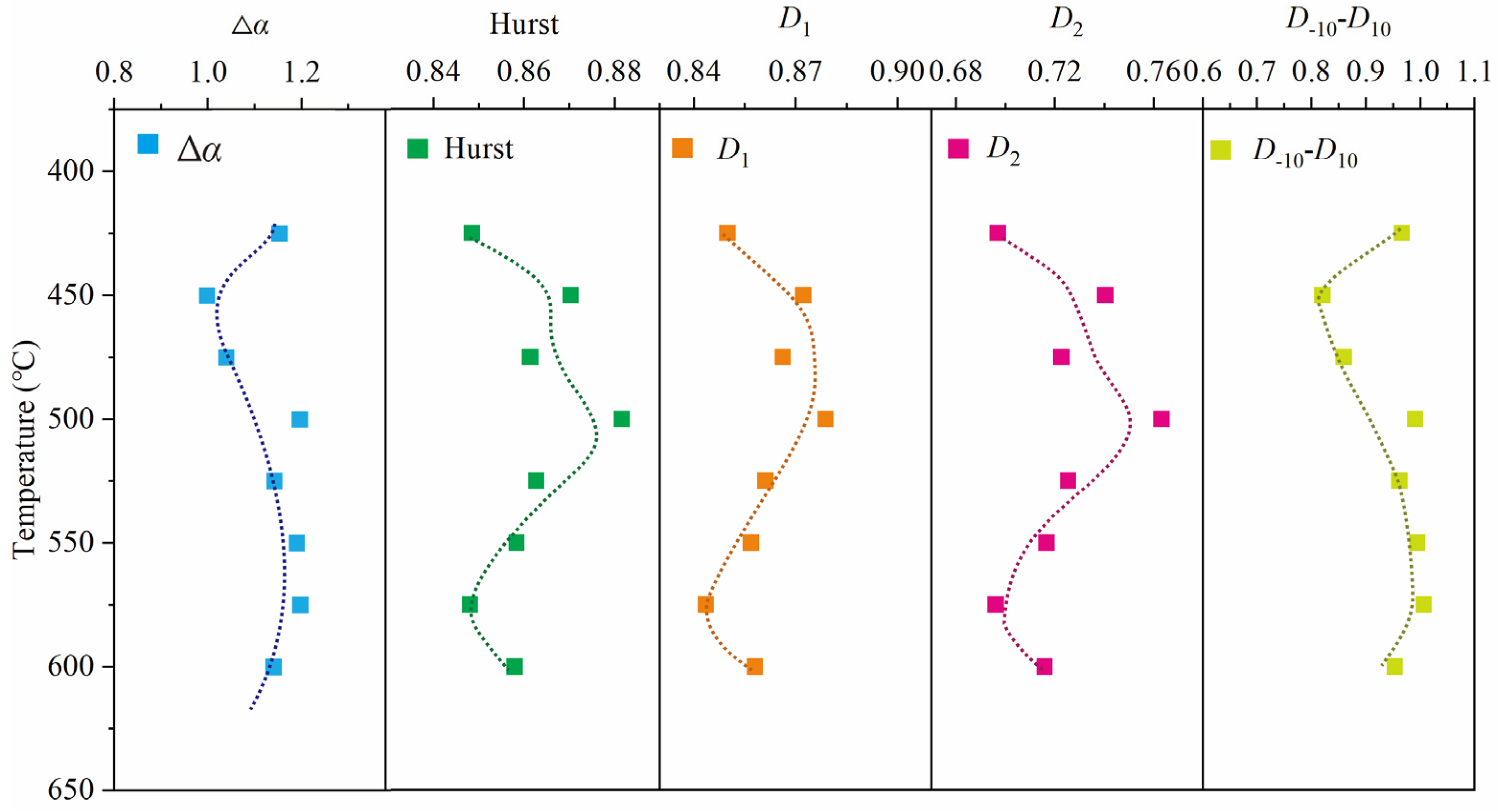
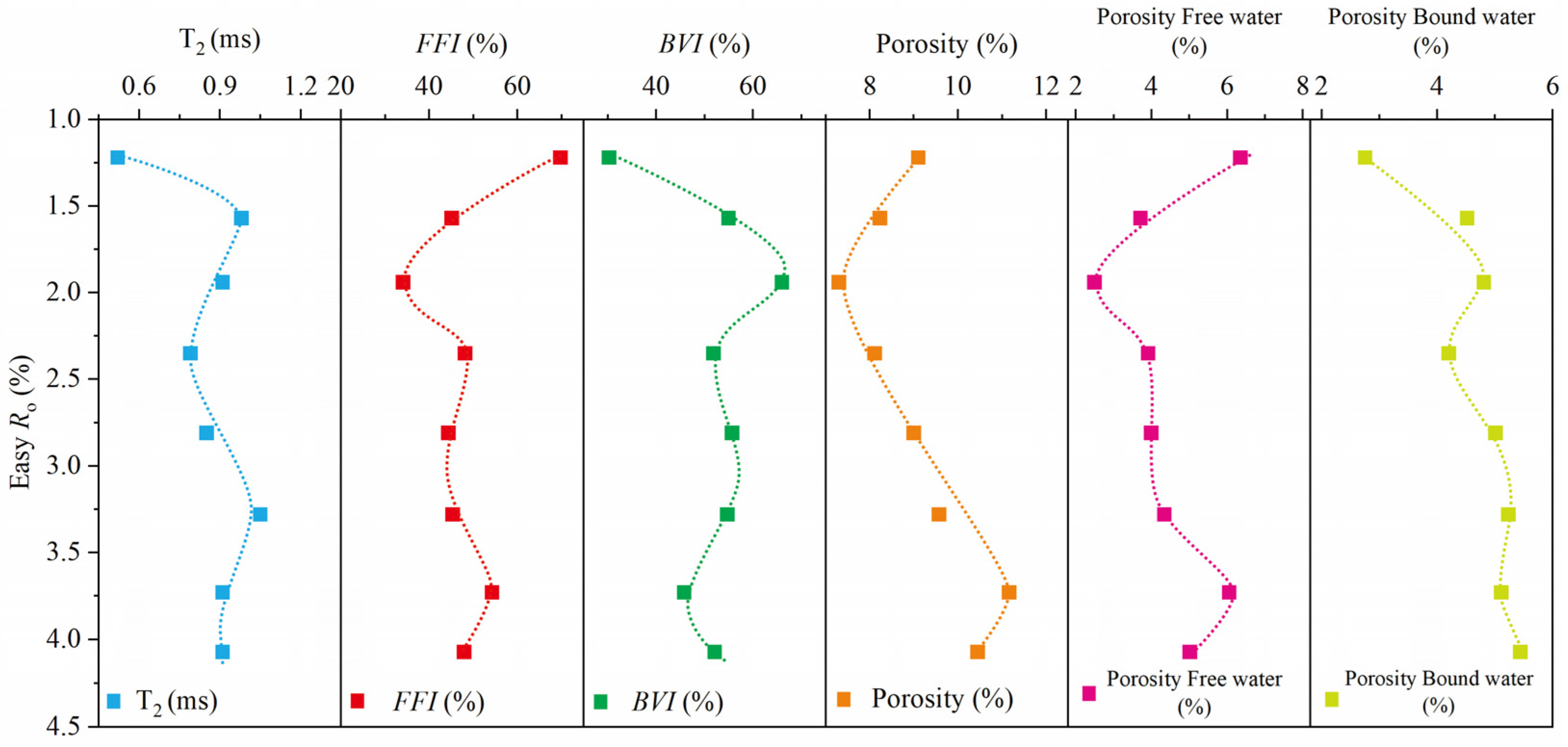
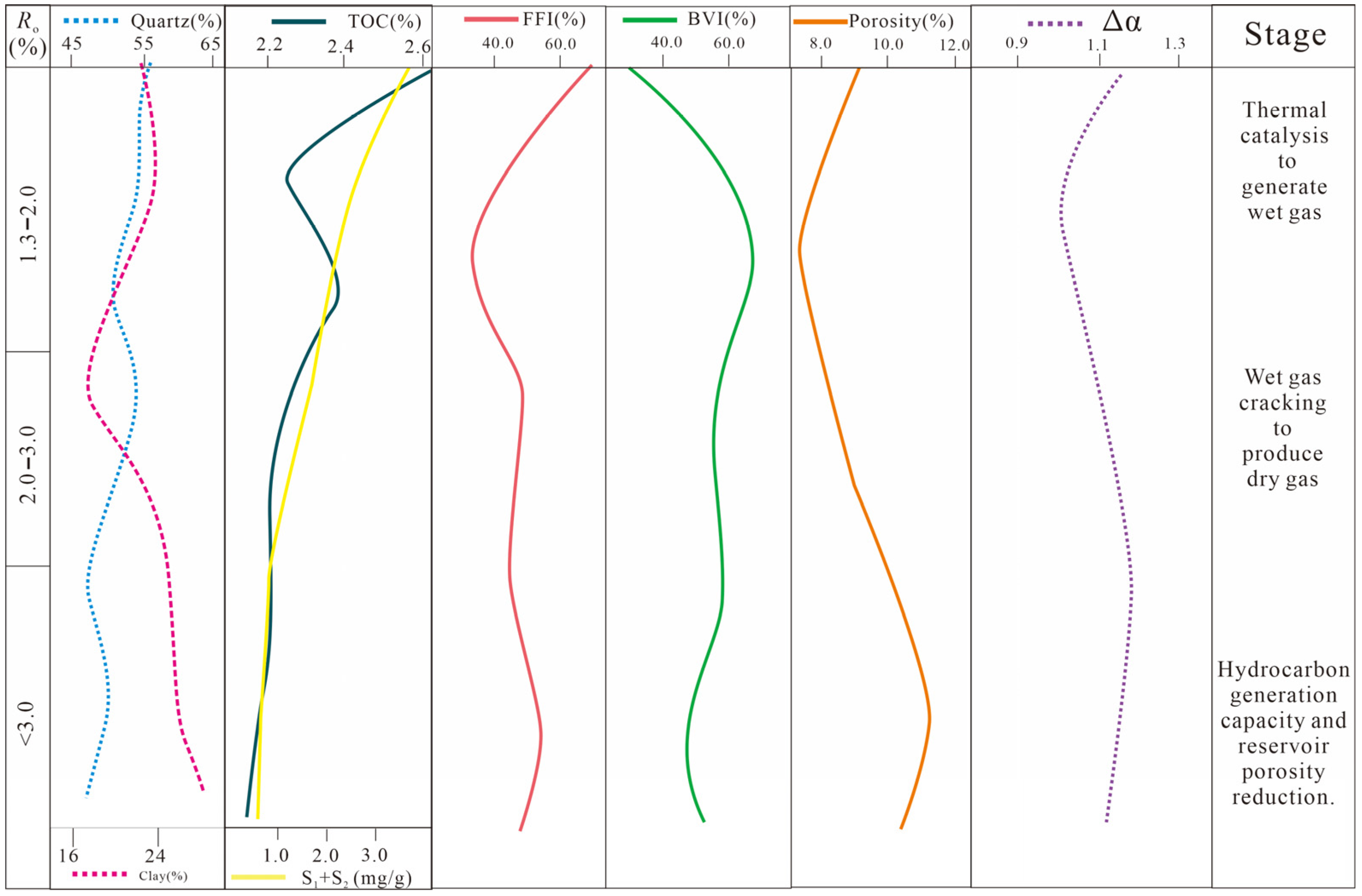
| Sample ID | Temperature (°C) | EqRo (%) | TOC (%) | S1 (mg/g) | S2 (mg/g) | S1 + S2 (mg/g) | Tmax (°C) |
|---|---|---|---|---|---|---|---|
| Z0 | - | 0.56 | 3.76 | 0.98 | 25.43 | 26.41 | 431 |
| Z1 | 425 | 1.22 | 2.55 | 2.21 | 16.53 | 18.74 | 515 |
| Z2 | 450 | 1.57 | 2.23 | 1.53 | 13.32 | 14.85 | 578 |
| Z3 | 475 | 1.94 | 2.37 | 1.32 | 11.87 | 13.19 | 584 |
| Z4 | 500 | 2.35 | 2.24 | 1.23 | 10.23 | 11.46 | 596 |
| Z5 | 525 | 2.81 | 2.2 | 0.86 | 7.97 | 8.83 | 603 |
| Z6 | 550 | 3.28 | 2.21 | 0.52 | 5.26 | 5.78 | 610 |
| Z7 | 575 | 3.73 | 2.18 | 0.47 | 4.41 | 4.88 | 623 |
| Z8 | 600 | 4.07 | 2.14 | 0.39 | 3.56 | 3.95 | 634 |
| Sample ID | Quartz (%) | K-Feldspar (%) | Plagioclase (%) | Dolomite (%) | Pyrite (%) | Clay (%) |
|---|---|---|---|---|---|---|
| Z-0 | 58.1 | 2.5 | 2.1 | 18.1 | 3.1 | 16.1 |
| Z-1 | 52.7 | 2.4 | 2 | 20.9 | 2.8 | 22 |
| Z-2 | 52.7 | 2.4 | 1.9 | 18.3 | 2.4 | 22.7 |
| Z-3 | 49.1 | 2.9 | 2.4 | 25.4 | 1.9 | 20.2 |
| Z-4 | 52.4 | 2.5 | 2.2 | 25.1 | 1.6 | 16.2 |
| Z-5 | 49.3 | 2.6 | 2.1 | 22.9 | 1.5 | 21.3 |
| Z-6 | 45.7 | 2.5 | 2 | 23.1 | 1.4 | 24.3 |
| Z-7 | 48.4 | 2.6 | 2.1 | 20.3 | 1.5 | 23.8 |
| Z-8 | 45.4 | 2.6 | 2 | 22.3 | 1.4 | 27.7 |
| Samples ID | T2c (mc) | FFI (%) | BVI (%) | ΦNMR (%) | ΦF (%) | ΦB (%) |
|---|---|---|---|---|---|---|
| Z1 | 0.52 | 69.73 | 30.27 | 9.1 | 6.35 | 2.75 |
| Z2 | 0.98 | 45.1 | 54.9 | 8.23 | 3.71 | 4.52 |
| Z3 | 0.91 | 34.05 | 65.95 | 7.3 | 2.49 | 4.81 |
| Z4 | 0.79 | 48.17 | 51.83 | 8.11 | 3.91 | 4.2 |
| Z5 | 0.85 | 44.35 | 55.65 | 9 | 3.99 | 5.01 |
| Z6 | 1.05 | 45.31 | 54.69 | 9.57 | 4.34 | 5.23 |
| Z7 | 0.91 | 54.23 | 45.77 | 11.16 | 6.05 | 5.11 |
| Z8 | 0.91 | 47.94 | 52.06 | 10.45 | 5.01 | 5.44 |
| Samples ID | Temperature | D0 | D1 | D2 | D0 − D1 | D−10 | D+10 | D−10 − D+10 | Hurst |
|---|---|---|---|---|---|---|---|---|---|
| Z0 | - | 1 | 0.8997 | 0.7682 | 0.1003 | 1.1577 | 0.5104 | 0.6472 | 0.8841 |
| Z1 | 425 | 1 | 0.8498 | 0.6969 | 0.1502 | 1.4250 | 0.4593 | 0.9657 | 0.8484 |
| Z2 | 450 | 1 | 0.8722 | 0.7404 | 0.1278 | 1.3268 | 0.5067 | 0.8201 | 0.8702 |
| Z3 | 475 | 1 | 0.8661 | 0.7226 | 0.1339 | 1.3414 | 0.4818 | 0.8596 | 0.8613 |
| Z4 | 500 | 1 | 0.8787 | 0.7631 | 0.1213 | 1.5284 | 0.5379 | 0.9904 | 0.8816 |
| Z5 | 525 | 1 | 0.8610 | 0.7253 | 0.1390 | 1.4503 | 0.4891 | 0.9612 | 0.8626 |
| Z6 | 550 | 1 | 0.8568 | 0.7165 | 0.1432 | 1.4786 | 0.4846 | 0.9940 | 0.8583 |
| Z7 | 575 | 1 | 0.8435 | 0.6960 | 0.1565 | 1.4705 | 0.4646 | 1.0059 | 0.8480 |
| Z8 | 600 | 1 | 0.8580 | 0.7158 | 0.1420 | 1.4330 | 0.4804 | 0.9527 | 0.8579 |
| Samples ID | Temperature | α0 | α1 | α2 | α−10 | α10 | α−10 − α0 | α0 − α+10 | Δα |
|---|---|---|---|---|---|---|---|---|---|
| Z0 | - | 1.0700 | 0.8997 | 0.6457 | 1.2356 | 0.4594 | 0.1655 | 0.6106 | 0.7761 |
| Z1 | 425 | 1.1153 | 0.8498 | 0.5718 | 1.5662 | 0.4134 | 0.4509 | 0.7019 | 1.1528 |
| Z2 | 450 | 1.0976 | 0.8722 | 0.6297 | 1.4540 | 0.4561 | 0.3564 | 0.6415 | 0.9979 |
| Z3 | 475 | 1.0988 | 0.8661 | 0.6019 | 1.4726 | 0.4336 | 0.3737 | 0.6652 | 1.0389 |
| Z4 | 500 | 1.1089 | 0.8787 | 0.6647 | 1.6807 | 0.4844 | 0.5718 | 0.6245 | 1.1963 |
| Z5 | 525 | 1.1206 | 0.8610 | 0.6108 | 1.5822 | 0.4403 | 0.4616 | 0.6803 | 1.1419 |
| Z6 | 550 | 1.1174 | 0.8568 | 0.6012 | 1.6259 | 0.4362 | 0.5085 | 0.6811 | 1.1897 |
| Z7 | 575 | 1.1314 | 0.8435 | 0.5766 | 1.6156 | 0.4182 | 0.4842 | 0.7132 | 1.1974 |
| Z8 | 600 | 1.1144 | 0.8580 | 0.5979 | 1.5727 | 0.4324 | 0.4582 | 0.6821 | 1.1403 |
Disclaimer/Publisher’s Note: The statements, opinions and data contained in all publications are solely those of the individual author(s) and contributor(s) and not of MDPI and/or the editor(s). MDPI and/or the editor(s) disclaim responsibility for any injury to people or property resulting from any ideas, methods, instructions or products referred to in the content. |
© 2023 by the authors. Licensee MDPI, Basel, Switzerland. This article is an open access article distributed under the terms and conditions of the Creative Commons Attribution (CC BY) license (https://creativecommons.org/licenses/by/4.0/).
Share and Cite
Wu, W.; Liang, Z.; Xu, L.; Liu, Y.; Li, Y.; Tang, X.; Yin, Y.; Chen, Y. The Effect of Thermal Maturity on the Pore Structure Heterogeneity of Xiamaling Shale by Multifractal Analysis Theory: A Case from Pyrolysis Simulation Experiments. Minerals 2023, 13, 1340. https://doi.org/10.3390/min13101340
Wu W, Liang Z, Xu L, Liu Y, Li Y, Tang X, Yin Y, Chen Y. The Effect of Thermal Maturity on the Pore Structure Heterogeneity of Xiamaling Shale by Multifractal Analysis Theory: A Case from Pyrolysis Simulation Experiments. Minerals. 2023; 13(10):1340. https://doi.org/10.3390/min13101340
Chicago/Turabian StyleWu, Wei, Zhikai Liang, Liang Xu, Yong Liu, Yi Li, Xianglu Tang, Yingzi Yin, and Yao Chen. 2023. "The Effect of Thermal Maturity on the Pore Structure Heterogeneity of Xiamaling Shale by Multifractal Analysis Theory: A Case from Pyrolysis Simulation Experiments" Minerals 13, no. 10: 1340. https://doi.org/10.3390/min13101340







